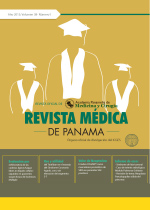Evaluación de ELISA de captura para NS1 como nueva herramienta del diagnóstico temprano de la infección por Dengue en Panamá.
Autores/as
DOI:
https://doi.org/10.37980/im.journal.rmdp.2013140Resumen
Introducción. El dengue es una enfermedad infecciosa endémica en Panamá, por lo cual debemos tener un algoritmo de diagnóstico sensible y rápido para realizar un diagnóstico temprano, tomar decisiones eficaces y reducir el riesgo de complicaciones. La detección del antígeno NS1 por ELISA de captura puede ser efectiva en suero a partir del 1er día de fiebre hasta el 9no día, es fácil, rápida y menos costosa que otras metodologías diagnósticas.
Objetivo. Comparar la sensibilidad de una ELISA comercial de captura para NS1 con otros métodos diagnósticos de dengue utilizados en Panamá.
Materiales y Métodos. Se analizaron 138 sueros provenientes de la Ciudad de Panamá para diagnóstico de dengue por ELISAs comerciales de captura para NS1 e IgM, detección del genoma viral por RT-PCR en tiempo real y aislamiento viral en cultivo celular, y se compararon los resultados obtenidos por cada método.
Resultados. La ELISA de NS1 permite obtener un diagnóstico para dengue en menos de 6 horas. En este estudio se detectó más positivos para NS1 que la RT-PCR o aislamiento viral, incrementando la sensibilidad de la sola detección de IgM (57.4%) a una sensibilidad conjunta (IgM y NS1) de 87.23%.
Conclusión. La ELISA de NS1 en conjunto con la IgM ofrece una sensibilidad de detección de 87.23% y un diagnóstico precoz de dengue, lo que sugiere que la implementación de la ELISA NS1 en las instalaciones de salud en Panamá permita un diagnóstico rápido acertado.
Abstract
Introduction. Dengue is an infectious disease endemic in Panama, and for this reason we need a sensitive and fast algorythm to realize early diagnosis, make efficient decisions and reduce the risk of complications. The detection of the NS1 antigen by ELISA can be effective in serum since the first day of fever to the 9th day, and it is easier, faster and less expensive than other diagnostic methods. Objective. To compare the detection sensibility of a commercial NS1 ELISA with other dengue diagnosis methods used in Panama. Materials and Methods. 138 sera from Panama city were analyzed for dengue diagnosis by a commercial ELISAs to detect NS1 and IgM, detection of the viral genome by real time RT-PCR and viral isolation in cell culture; and the results obtained for each method were compared. Results. The ELISA to detect NS1 can give diagnostic results in less than 6 hours. In this study it detected more dengue positive samples than by RT-PCR or virus isolation, increasing the sensibility of the sole detection of the IgM (57.4%) to a combined sensibility (IgM and NS1) of 87.23%. Conclusion. The commercial NS1 ELISA combine with the IgM detection offers a sensibility of detection of 87.23% and an early diagnossis of dengue. This suggest that the implementation of the NS1 ELISA in the health facilities in Panama allows a fast and reliable diagnostic test.
Key words: dengue, diagnosis, NS1 (non structural protein1), NS1 capture ELISA, IgM, viral genome, RT-PCR, viral isolation, sensibility.
Publicado
Número
Sección
Licencia
Derechos autoriales y de reproducibilidad. La Revista Médica de Panama es un ente académico, sin fines de lucro, que forma parte de la Academia Panameña de Medicina y Cirugía. Sus publicaciones son de tipo acceso gratuito de su contenido para uso individual y académico, sin restricción. Los derechos autoriales de cada artículo son retenidos por sus autores. Al Publicar en la Revista, el autor otorga Licencia permanente, exclusiva, e irrevocable a la Sociedad para la edición del manuscrito, y otorga a la empresa editorial, Infomedic International Licencia de uso de distribución, indexación y comercial exclusiva, permanente e irrevocable de su contenido y para la generación de productos y servicios derivados del mismo. En caso que el autor obtenga la licencia CC BY, el artículo y sus derivados son de libre acceso y distribución.






